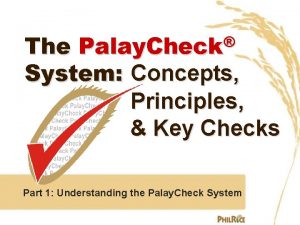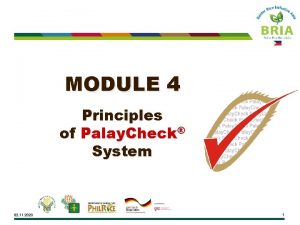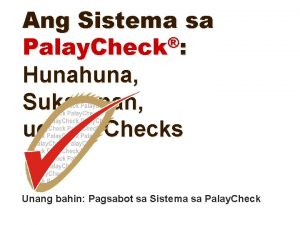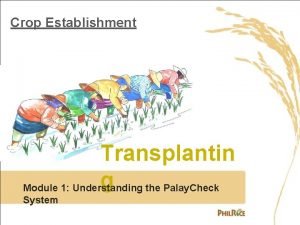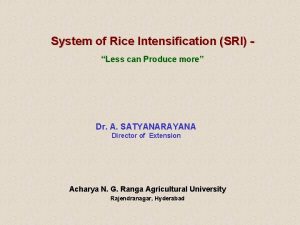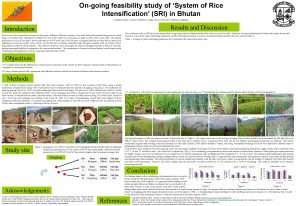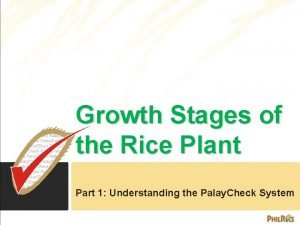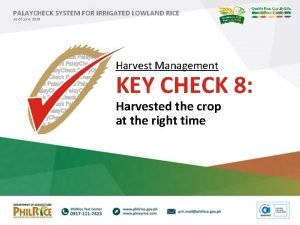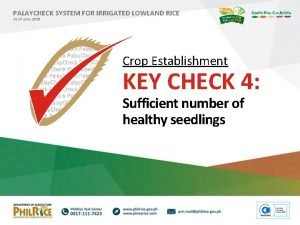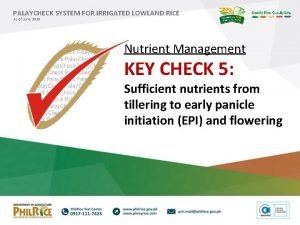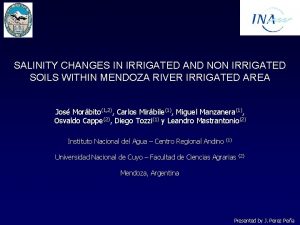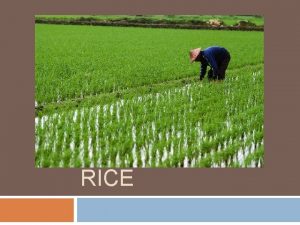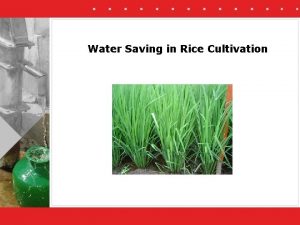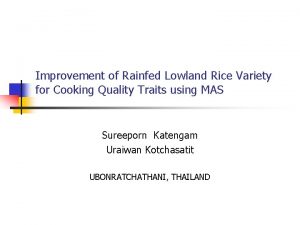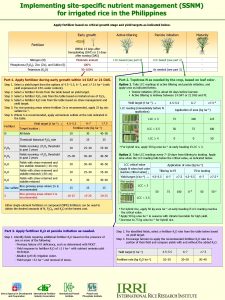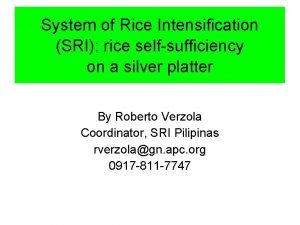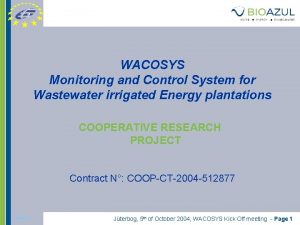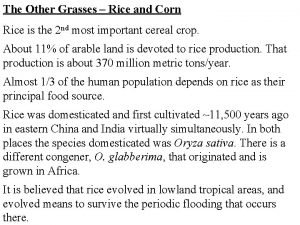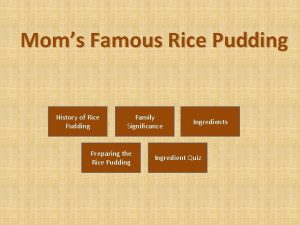PALAYCHECK SYSTEM FOR IRRIGATED LOWLAND RICE As of






















- Slides: 22

PALAYCHECK SYSTEM FOR IRRIGATED LOWLAND RICE As of June 2020 Land Preparation KEY CHECK 2: Well-leveled field 1 1

What do you observe in the two pictures? Which seems well-leveled, A or B? Why? A 2 What are the benefits of a well-leveled field? B

Importance of Key Check 2 A well-leveled field is a pre-requisite to good crop growth and management 3 3 • efficient water management • less weed incidence • better snail management • efficient nutrient utilization • uniform crop growth and maturity • efficient use of farm machinery

Importance of Key Check 2 A well-leveled field is a pre-requisite to good crop growth and management. To achieve a wellleveled field, weeds, rice straw, and stubbles must be thoroughly decomposed and land is well-puddled. 4 4 • efficient water management • less weed incidence • better snail management • efficient nutrient utilization • uniform crop growth and maturity • efficient use of farm machinery

If field is not well-leveled. . . 5% Y i redu eld ction • more water is needed to drench the soil, reducing water use and time efficiency. • there is increased weed incidence, difficulty in managing snails, proper nutrient utilization, uneven crop growth and maturity that results to inefficient use of water, reduced grain quality, and yield reduction. 5

Assessment of Key Check 2 • 6 No high and low soil spots after final leveling: • no portion has deeper than 5 cm water (≈ thumb length) • no mound of soil can be seen above the 5 cm water surface after final leveling.

Recommendations to Achieve Key Check 2 1. Clean and repair dikes and ditches. • Clean dikes help prevent or reduce pest infestation. • Compacted dikes prevent seepage. • Dikes maintained at 15 cm high x 20 cm wide discourage rat-burrowing. • Clean ditches ensure water efficiency and facilitate drainage. 7

Recommendations to Achieve Key Check 2 2. Plow or rotovate field 21 -30 days before planting to: • allot time for the germination of weeds and drop seeds • incorporate weeds, rice straw, & stubbles in the soil to allow time for decomposition • apply organic fertilizers to increase the population of beneficial microbials and hasten the full decomposition of plant residues If organic materials are not fully decomposed, soil becomes acidic & some nutrients become less available. 8

Recommendations to Achieve Key Check 2 3. Harrow the field every 7 days after plowing. The first harrowing is along the plowing pattern; the second or initial leveling is crosswise. This will: • break the clods • incorporate stubbles in the soil • allow weed seeds to germinate • help reduce initial pest population • maintain the soil’s hard pan 9

Recommendations to Achieve Key Check 2 4. Final-harrow and level the field using a wooden plank or tiller-attached leveler. • allows uniform water distribution • facilitates easier irrigation and drainage Water depth must be 5 cm to ease field-leveling. 10

Recommendations to Achieve Key Check 2 5. For direct wet-seeded rice (DWSR), construct small canals (25 cm wide and 5 cm deep) surrounding the field near the dikes at the middle of the field to: • provide path for excess water • facilitate collection of snails and field operations (i. e. replanting, weeding) 11

Recommendations to Achieve Key Check 2 For example: Plowing 1 st harrowing 2 nd harrowing (initial leveling) Final harrowing and leveling PLANTING REST PERIOD day 0 12 day 7 day 14 day 21

Input • dikes & ditches cleaned & repaired • prepared the field 21 -30 days before planting Output Well-leveled field • • • 13 Outcome decomposed plant residues reduced pests uniform crop growth and maturity efficient water and nutrient uptake better crop management • high yield • high grain quality • minimal damage to environment

PALAYCHECK SYSTEM FOR IRRIGATED LOWLAND RICE As of June 2020 Land Preparation KEY CHECK 2: Well-leveled field 14 1414

Production Assistant: Mr. Mark Edison Bautista Technical Reviewers: Dr. Aurora Corales; Dr. Arnold Juliano; Engr. Marvin Manalang; Dr. Manuel Jose Regalado Courseware Reviewers: Ms. Lea d. R. Abaoag; Ms. Ev Angeles Note: Presentation adapted from original version produced by Phil. Rice in 2011. Revisions made in 2019 based on results of a series of consultation workshops with Phil. Rice R&D staff. You may use, remix, tweak, & build upon this presentation non-commercially. However, always use with acknowledgment. Unless otherwise stated, the names listed are Phil. Rice staffers. 15

Review! 16

What is the assessment for Key Check 2? • 17 No high and low soil spots after final leveling: • no portion has deeper than 5 cm water (≈ thumb length) • no mound of soil can be seen above the 5 cm water surface after final leveling.

What are the recommendations to achieve Key Check 2? Clean & _______ repair dikes & ditches. 1. _______ 21 -30 2. Plow/rotovate field ______ days before planting. every 7 days 3. Harrow the field _______after plowing. The first harrowing is along the plowing pattern; the second or initial leveling is crosswise. Final harrow level 4. ________ and ______ the field using a wooden plank or tiller-attached leveler. 18

Why is it important to clean and repair dikes and ditches before planting? • Clean dikes help prevent or reduce pest infestation • Compacted dikes prevent seepage. • Dikes maintained at 15 cm high x 20 cm wide discourage rat-burrowing. • Clean ditches ensure water efficiency and facilitate drainage. 19

Why do we need to prepare the field 21 -30 days before planting? Generally, 30 days gives enough time for weeds and drop seeds to germinate and get destroyed through tillage (plowing, harrowing). It is important to control the drop seeds to lessen the source of off-types. Also, to allow proper decomposition of plant residues that will later add to soil nutrients. . 20

Give examples of negative effects of a poorlyleveled field? • • • 21 higher weed incidence poor snail management less efficient nutrient utilization uneven crop growth & maturity less efficient use of water & application of controlled irrigation practices less efficient use of farm machinery

If the field is not well-leveled, what is the expected yield reduction in percent? Answer: 5% Yield reductio n 22
 Erie lowland
Erie lowland Yugoslavia only existed from the 1940s to the 1990s because
Yugoslavia only existed from the 1940s to the 1990s because Key check
Key check Palaycheck system meaning
Palaycheck system meaning Ug binhi kultura
Ug binhi kultura Dapog nursery advantages and disadvantages
Dapog nursery advantages and disadvantages Sri system of rice intensification
Sri system of rice intensification Sri system of rice intensification
Sri system of rice intensification Sri system of rice intensification
Sri system of rice intensification System of rice intensification
System of rice intensification Stages of rice plant
Stages of rice plant Allegro productivity toolbox
Allegro productivity toolbox Kontinuitetshantering i praktiken
Kontinuitetshantering i praktiken Novell typiska drag
Novell typiska drag Nationell inriktning för artificiell intelligens
Nationell inriktning för artificiell intelligens Vad står k.r.å.k.a.n för
Vad står k.r.å.k.a.n för Shingelfrisyren
Shingelfrisyren En lathund för arbete med kontinuitetshantering
En lathund för arbete med kontinuitetshantering Särskild löneskatt för pensionskostnader
Särskild löneskatt för pensionskostnader Tidbok yrkesförare
Tidbok yrkesförare Sura för anatom
Sura för anatom Densitet vatten
Densitet vatten Datorkunskap för nybörjare
Datorkunskap för nybörjare


